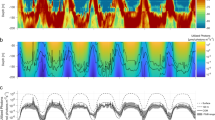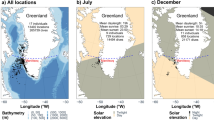Abstract
The vertical migration of zooplankton into lower and darker water strata by day is generally explained by the avoidance of visually orienting predators, mainly fish1,2,3,4; however, it is unclear why daily zooplankton migration has been maintained in fishless areas5. In addition to predation, ultraviolet radiation—a hazardous factor for zooplankton in the surface layers of marine and freshwater environments6,7,8—has been suspected as a possible cause of daytime downward migration9. Here we test this hypothesis by studying several Daphnia species, both in a controlled laboratory system and under natural sunlight in an outdoor system. We selected Daphnia species that differed in their pigmentation as both melanin and carotenoids have been shown to protect Daphnia from ultraviolet light10,11. All Daphnia species escaped into significantly deeper water layers under ultraviolet radiation. The extent to which the daphnids responded to this radiation was inversely linked to their pigmentation, which reduced ultraviolet transmission. These results suggest that ultraviolet avoidance is an additional factor in explaining daytime downward migration. Synergistic benefits might have shaped the evolution of this complex behaviour.
This is a preview of subscription content, access via your institution
Access options
Subscribe to this journal
Receive 51 print issues and online access
$199.00 per year
only $3.90 per issue
Buy this article
- Purchase on Springer Link
- Instant access to full article PDF
Prices may be subject to local taxes which are calculated during checkout



Similar content being viewed by others
References
Zaret, T. M. & Suffern, J. S. Vertical migration in zooplankton as a predator avoidance mechanism. Limnol. Oceanogr. 21, 804–813 (1976).
Stich, H. B. & Lampert, W. Predator evasion as an explanation of diurnal vertical migration by zooplankton. Nature 293, 396–398 (1981).
Neill, W. E. Induced vertical migration in copepods as a defence against invertebrate predation. Nature 345, 524–526 (1990).
De Meester, L., Weider, L. J. & Tollrian, R. Alternative antipredator defences and genetic polymorphism in a pelagic predator–prey system. Nature 378, 483–485 (1995).
Williamson, C. E. et al. Ultraviolet radiation and zooplankton community structure following deglaciation in Glacier Bay, Alaska. Ecology (in the press).
Calkins, J. & Thordadottir, T. The ecological significance of solar UV radiation on aquatic organisms. Nature 283, 563–566 (1980).
Williamson, C. E., Zagarese, H. E., Schulze, P. C., Hargreaves, B. R. & Seva, J. The impact of short-term exposure to UV-B radiation on zooplankton communities in north temperate lakes. J. Plankton Res. 16, 205–218 (1994).
Siebeck, O. & Böhm, U. Challenges for an appraisal of UV-B effects upon planktonic crustaceans under natural radiation conditions with a non-migrating (Daphnia pulex obtusa) and a migrating cladoceran (Daphnia galeata). Arch. Hydrobiol. Beih. Ergebn. Limnol. 43, 197–206 (1994).
Kerfoot, W. C. Adaptive value of vertical migration: comments on the predator hypothesis and some alternatives. Contr. Mar. Sci. Suppl. 27, 91–113 (1985).
Hairston, N. G. Jr Photoprotection by carotenoid pigments in the copepod Diaptomus nevadensis. Proc. Natl Acad. Sci. USA 73, 971–974 (1976).
Hebert, P. D. N. & Emery, C. J. The adaptive significance of cuticular pigmentation in Daphnia. Funct. Ecol. 4, 703–710 (1990).
Lampert, W. The adaptive significance of diel vertical migration of zooplankton. Funct. Ecol. 3, 21–27 (1989).
De Meester, L., Dawidowicz, P., van Gool, E. & Loose, C. J. in The Ecology and Evolution of Inducible Defenses (eds. Tollrian, R. & Harvell, C. D.) 160–176 (Princeton Univ. Press, Princeton, New Jersey, 1999).
Ringelberg, J. The positively phototactic reaction of Daphnia magna Strauss: a contribution to the understanding of diurnal vertical migration. Neth. J. Sea Res. 2, 319–406 (1964).
Bollens, S. M., Frost, B. W. & Cordell, J. R. Chemical, mechanical and visual cues in the vertical migration behavior of the marine planktonic copepod Acartia hudsonica. J. Plankton Res. 16, 555–564 (1994).
Loose, C. J. & Dawidowicz, P. Trade-offs in diel vertical migration by zooplankton: The costs of predator avoidance. Ecology 75, 2255–2263 (1994).
Fleischmann, E. M. The measurement and penetration of ultraviolet radiation into tropical marine water. Limnol. Oceanogr. 34, 1623–1629 (1989).
Morris, D. P. et al. The attenuation of solar UV radiation in lakes and the role of dissolved organic carbon. Limnol. Oceanogr. 40, 1381–1391 (1995).
Smith, K. C. & Macagno, E. R. UV photoreception in the compound eye of Daphnia magna (Crustacea, Branchiopoda). A fourth spectral class in single ommatidia. J. Comp. Physiol. A 166, 597–606 (1990).
Merker, E. Sehen die Daphnien ultraviolettes Licht? Zool. Jahrb. Abt. Allg. Zool. Physiol. Tiere. 48, 277–348 (1930).
Hessen, D. O. Daphnia responses to UV-light. Arch. Hydrobiol. Beih. 43, 85–195 (1994).
Storz, U. C. & Paul, R. J. Phototaxis in water fleas (Daphnia magna) is differently influenced by visible and UV light. Comp. Physiol. A 183, 709–717 (1998).
Leech, D. M. & Williamson, C. E. In situ exposure to ultraviolet radiation alters the depth distribution of Daphnia. Limnol. Oceanogr. 46, 416–420 (2001).
Damkaer, D. M. in The Role of Solar Ultraviolet Radiation in Marine Ecosystems (ed. Calkins, J.) 701–706 (Plenum, New York, 1982).
Dodson, S. I. Predicting diel vertical migration of zooplankton. Limnol. Oceanogr. 35, 1195–1200 (1990).
Smith, R. C. & Baker, K. S. Optical properties of the clearest natural waters (200–800 nm). Appl. Optics 20, 177–184 (1981).
Vinyard, G. L. & O'Brien, W. J. Effects of light and turbidity on the reactive distance of bluegill (Lepomis macrochirus). J. Fish. Res. Bd. Can. 33, 2845–2849 (1976).
Confer, J. L. et al. Visual predation by planktivores. Oikos 31, 27–37 (1978).
Madronich, S., McKenzie, R. L., Caldwell, M. M. & Bjorn, L. Changes in ultraviolet radiation reaching the earth's surface. Ambio 24, 143–152 (1995).
Acknowledgements
We thank L. J. Weider for providing arctic D. pulex. We also thank A. Agrawal, W. Gabriel, S. Gießler, A. F. Sell, B. Schierwater, T. Vines, C. E. Williamson, W. C. Kerfoot and L. J. Weider for comments and advice on earlier versions of the manuscript.
Author information
Authors and Affiliations
Corresponding author
Rights and permissions
About this article
Cite this article
Rhode, S., Pawlowski, M. & Tollrian, R. The impact of ultraviolet radiation on the vertical distribution of zooplankton of the genus Daphnia. Nature 412, 69–72 (2001). https://doi.org/10.1038/35083567
Received:
Accepted:
Issue Date:
DOI: https://doi.org/10.1038/35083567
This article is cited by
-
Shelter selection by intertidal amphipods: the role of UVR and photoprotective compounds
Aquatic Ecology (2022)
-
Diel vertical migration of copepods and its environmental drivers in subtropical Bahamian blue holes
Aquatic Ecology (2021)
-
Impacts of ocean acidification under multiple stressors on typical organisms and ecological processes
Marine Life Science & Technology (2020)
-
Zooplankton and micronekton respond to climate fluctuations in the Amundsen Sea polynya, Antarctica
Scientific Reports (2019)
-
Photobehaviors of the calanoid copepod Calanus sinicus from the Yellow Sea to visible and UV–B radiation as a function of wavelength and intensity
Journal of Oceanology and Limnology (2019)
Comments
By submitting a comment you agree to abide by our Terms and Community Guidelines. If you find something abusive or that does not comply with our terms or guidelines please flag it as inappropriate.



